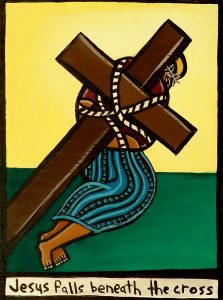By J. A. Gleichman
Iconographer and painter Laura James is currently creating a permanent installation based on the Stations of the Cross for three churches in Haiti.
Early experiences with racial bias, particularly in the Bible picture books of her childhood, caused James to look away from that faith and then look back.
Finding relief in Ethiopian history, and her vocation as an artist, Laura James takes the way of the cross from brutality to uplift and does not stop inspiring or being inspired along the way.
This fall, St. Jean Baptiste Parish in Sassier, Haiti will receive fourteen of Laura’s Stations of the Cross paintings with text written in Creole. From Here to Haiti partnered with the artist to bring the work to these communities.
“Part of our purpose is to create pleasant, safe community spaces, places for the faithful to go to worship. This project moves that goal forward.” – Joseph Brintle, Treasurer, From Here to Haiti.
 Sassier is in southwestern Haiti and the parish serves close to 10,000 people. An indiegogo campaign is underway to raise money for the creation, transport and installation of The Stations of the Cross.
Sassier is in southwestern Haiti and the parish serves close to 10,000 people. An indiegogo campaign is underway to raise money for the creation, transport and installation of The Stations of the Cross.
“At first I thought raising twenty thousand dollars for this art to hang in a church in an area facing enormous challenges: an earthquake, problems with water, serious health care issues, etc… was not practical. But I always came back to, ‘Why shouldn’t the people of Sassier have nice things too? Luxuries even?’ I want them to see these paintings and not only be spiritually uplifted but also know that people half a world away know that they are there, care, and respect them, and want to make an impression on their lives.” – Laura James
Framed reproductions will also be given to St. Gerard Majella Parish in Chardonnette and St. Paul Parish in Moulines. Patricia Brintle, President of From Here to Haiti, recalls meeting with one of the pastors of a church that will receive the art:
“The pastor of St. Gerard Majella, in Chardonnette, was visiting me in NY last year and he saw me about to throw away an advertisement book I had just received. It contained little drawings of the Stations of the Cross. He asked if he could have it. I gave it without a thought. Our team subsequently traveled to Chardonnette to repair the church, and as I entered I noticed the small pages of the book I gave him pasted along the wall. This was the Stations of the Cross the faithful had for their service. I was saddened but knew that one day we would work at getting a proper set for the faithful of St. Gerard.”
The Stations of the Cross illustrate the most painful and profound arc in the story of Jesus in the gospels. What happens after viewing the series depends on how you see yourself and others in the story, if you do. Who are the people along the way? What did Jesus achieve? Where do I fit in the story? Making a space for memorial and private devotion in a sacred place elevates and challenges a soul in a way no words express. Laura James’ work is an invitation to experience that uplift and ineffable awe.
 Dr. John Munoz, a collector specializing in religious art, first saw James’ work at her show for The College of New Rochelle in 2008.
Dr. John Munoz, a collector specializing in religious art, first saw James’ work at her show for The College of New Rochelle in 2008.
“The emotional impact of even formal seeming scenes is very powerful. Her use of shapes, colors, composition and movement is superb. I was naturally drawn to a small Black Madonna painting; it seemed to have just been rescued from an ancient tomb and I fell in love with it immediately.”
Just over ten years ago, Liturgy Training Publications (LTP) commissioned James to create a series based on scenes from the Gospels for The Book of the Gospels. It is used internationally in the Mass of the Roman Catholic Church and other denominations; it also won an award from the Catholic Press Association.
“I’m attracted to her work because it reminds me of 4th century Ethiopian Christian art; there’s this historical quality to it and yet there’s something about it that’s also fresh and contemporary,” says Jeanne Kortekamp, Director of Design for Franciscan Media, “I trust Laura to capture a feel that seems biblically accurate.”
Q&A with Laura James:
What was your first commission?
It was a book cover, The Bible Documents, for LTP. They wanted to see a woman leading a lively discussion, a bible study group. Before it was printed, before I even finished the work, the publisher asked if I could illustrate their Book of the Gospels; so it was a one-two punch. Being asked to illustrate an entire book, thirty-four pictures based on the Gospels, was very exciting.
Do you have a favorite illustration from the Book of the Gospels commission?
My favorite picture is Fish for Breakfast. It’s so different from the rest of the images—there’s something really calm about it. I like the lines of the water, the fire and the smoke. I like that Jesus is feeding everyone and that it’s morning. This work is the only one I kept from the series; it’s my painting.
Which images receive the strongest feedback?
Jesus Calms the Storm and Jesus Walks on Water are two really popular pieces, and the detail of The Crucifixion from the Easter painting. Psalm 100 and Love One Another also receive a lot of feedback from people—publishers seem to use these images over and over.
Challenging aspects of any liturgical commissions?
Getting everything into the picture that I want to show, I mean, not leaving out anything that’s important to the story. Telling the story as it’s written in the Bible—doing it straight. Obviously I have my own ideas and I like to paint pictures that aren’t religious, but with a sacred text, it’s important not to add anything.
What’s your research process like?
I always look at the King James Version first, and then go on to more modern translations for different views or sources on a scene. Also, to get a good feel for what’s been done before, I look at pictures and icons from all over the place. I really like Ethiopian, Byzantine and Russian iconography, Gothic Painting, and just all kinds of sacred art. I also like to see what the “famous” images look like—to see how other artists interpreted it, and what they left out or focused on. Every artist does it so differently and I can do it differently too.
Which theme in the biblical narratives means the most to you?
Love One Another. It’s idealistic, I know, Jesus was talking about it two-thousand years ago, maybe we’ll get there.
ED’s note: J.A. Gleichman writes about spirituality, art and design. She lives in the United States.
Please follow Laura’s project on:
#TheStationsoftheCross
#TheStationsforSassier
#FromHeretoHaiti
 TPLF re-elects Debretsion as Chairman, suspends Tigray Interim Admin President, others from party membership
TPLF re-elects Debretsion as Chairman, suspends Tigray Interim Admin President, others from party membership World Bank provides $1B grant, $500M concessional credit for Ethiopia
World Bank provides $1B grant, $500M concessional credit for Ethiopia Malawi court acquits former president’s son over charges involving death of 29 suspected Ethiopian migrants
Malawi court acquits former president’s son over charges involving death of 29 suspected Ethiopian migrants Electric Utility, Huawei sign MoU to provide alternative electricity to communities in off-grid areas
Electric Utility, Huawei sign MoU to provide alternative electricity to communities in off-grid areas